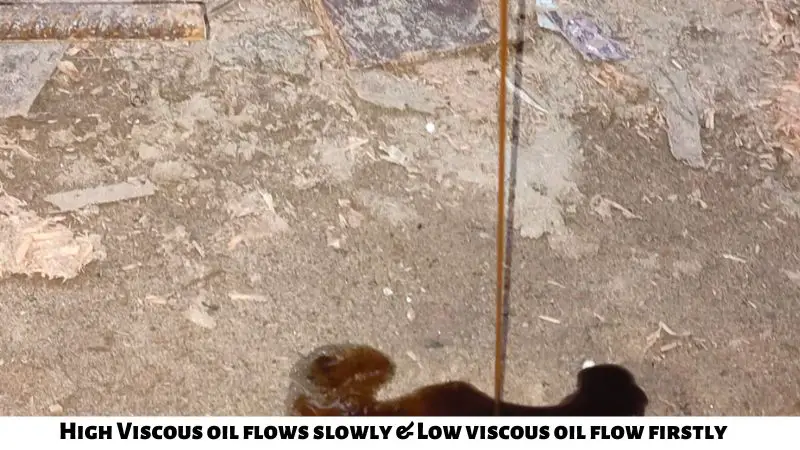Viscosity is one of the essential characteristics of any kind of oil. To understand the primary condition & application of any engine oil or lubricants you must know the oil’s viscosity.
What is viscosity
Viscosity is the internal resistance to the flow of a fluid or this is the basic parameter of oil or any fluid by which we can understand how much thicker or thinner the oil is.
Shortly you can also say that viscosity is the internal resistance of oil to flow. For example, if you pour Olive oil & Honey from the same place then you will see that olive oil is going faster than honey, this is because of the higher viscosity of honey. Just like this if any oil moves more slowly than other oil, that means the oil is more viscous than the other oil.

There are two types of viscosity, one is kinematic viscosity & another is dynamic viscosity.
Oil viscosity units are different for both types. And the measurement of viscosity is also different for these two types of viscosity. Kinematic viscosity is the oil resistance to flow created internally due to shear & gravity.
The unit of kinematic viscosity is Stokes (St) or Centistokes (cSt). The kinematic viscosity of any medium would be found by following the formula:
ν = η / ρ
Where η is the dynamic viscosity of oil & ρ is the density of the medium. Generally, kinematic viscosity is expressed by m²/s
On the other hand, dynamic or absolute viscosity is the internal resistance that is created by the movement of the medium from one layer or another layer. The SI unit of dynamic viscosity is Pascal-Second (Pa S), in this way, you will get the viscosity of oil in cp or centipoise.
Viscosity Index:
If you deal with oil viscosity then you must have to know what is viscosity index. It is a measurement unit by which you can understand the viscosity change rate of any oil concerning the temperature change. Sometimes for the better performance of any oil viscosity index improvers & viscosity modifiers are used.
How to measure the viscosity of oil:
As viscosity is a very important part of any oil & lubrication so you should also know about the way to measure the viscosity of the oil. You can do it with an oil viscosity test kit. let’s discuss:
Capillary Tube Viscometer
In this method, the oil sample is placed in a U-shaped Glass capillary tube. The oil Sample is drawn towards a suction head when the suction head is released. And then oil flows through a narrow capillary section due to the gravity of the oil. This capillary section also controls the flow rate of oil & calculates the resistance of the oil. This is the standard procedure of testing the kinematic viscosity of oil by a Capillary tube viscometer & known as ASTM D445 and ISO 3104. Depending on the resulting requirement sometimes this process is needed to be modified or converted into an automation system. But this is the most commonly used method for oil viscosity tests.
But in this method, one important thing is that stating viscosity without temperature is meaningless. So it is very important to know the temperature, at which the kinematic viscosity is calculated.

Rotary Tube Viscometer
A rotary tube viscometer is another oil viscosity test kit which not commonly used. By this method, the dynamic viscosity of the oil is calculated in a fixed temperature system. In this system, there is a spindle in the insulated glass tube at a constant temperature. When the sample oil is placed in the glass tube then the spindle started to rotate at a fixed rpm. The viscosity is measured from the required torque to rotate the spindle against the oil shear stress. And thus way dynamic viscosity of the oil is measured & expressed in Centipose (cP). This method is described in ASTM D2983 and is also known as the Brookfield method.
To understand the formulation of multigrade engine oil like 15W-40 you need to understand the SAE oil viscosity chart. And for this bot,h methods are important as kinematic viscosity gives the idea of viscosity limits of oil & dynamic viscosity of oil gives the idea of the minimum requirement of clod cranking.
How to test oil viscosity at home:
Without any oil viscosity test kit, you can also measure the viscosity of the oil. But this test is very much complicated & risky. So you have to maintain safety & careful for the perfect result.
In this method, you have to take a container with full water at 100° temperature & most important part of the test is that you have to maintain this temperature for the entire method. Then an open-ended U-shaped glass tube has to submerge into the boiled water in such a way so that the bend of the U shape tube is submerged into the water & the end of the tube is open in the air.
Now seal one end of the tube & place the sample oil into the other end. Then using a stopwatch see how much time is needed to raise the oil temperature & reaching the last sealed end of the tube. Once the Oil reached the sealed end, remove the seal and also record the time to fall the oil.
Taking a too long time to raise & fall you have to understand that the more viscous the oil is. For accurate viscosity results, you may use the viscosity measurement formula.
Final Word:
To understand the type of oil even the quality of oil you must know about the viscosity of the oil. Best if you have the SAE viscosity chart of the oil. So first of all, know about the viscosity, check the manufacturer’s recommendation and finally take the right oil.
Read Also:
